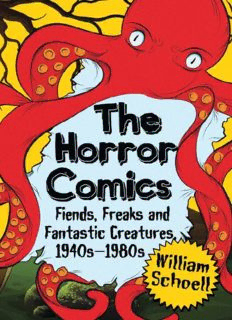
The Horror Comics: Fiends, Freaks and Fantastic Creatures, 1940s–1980s PDF
Preview The Horror Comics: Fiends, Freaks and Fantastic Creatures, 1940s–1980s
Also by WILLIAM SCHOELL Creature Features: Nature Turned Nasty in the Movies (McFarland, 2008, paperback 2014) The Opera of the Twentieth Century: A Passionate Art in Transition (McFarland, 2006) The Horror Comics Fiends, Freaks and Fantastic Creatures, 1940s–1980s WILLIAM SCHOELL McFarland & Company, Inc., Publishers Jefferson, North Carolina Illustrations are from the author’s collection. LIBRARY OF CONGRESS CATALOGUING DATA ARE AVAILABLE BRITISH LIBRARY CATALOGUING DATA ARE AVAILABLE e-ISBN: 978-1-4766-1835-7 © 2014 William Schoell. All rights reserved No part of this book may be reproduced or transmitted in any form or by any means, electronic or mechanical, including photocopying or recording, or by any information storage and retrieval system, without permission in writing from the publisher. On the cover: Octopus and background landscape © 2014 iStock/Thinkstock McFarland & Company, Inc., Publishers Box 611, Jefferson, North Carolina 28640 www.mcfarlandpub.com To the memory of my grandfather, Jacob Schoell, whom I take after in many ways Table of Contents Preface Part I: The Golden Age, Pre–1956 One: American Comics Group (ACG) Two: EC Comics Three: Prize Comics Four: Atlas, Timely and Marvel Five: DC, Fawcett, Charlton and Harvey Six: Ace and Ajax-Farrell Seven: Avon, Better/Nedor, Comic Media and More Eight: Key, St. John’s, Story, Quality, Smaller and Canadian Publishers Part II: The Silver Age, 1956–1969 Nine: Marvel, DC and Charlton Ten: Dell and Gold Key Part III: The Bronze Age, 1970–1983 Eleven: Dracula, Frankenstein and Werewolf by Night Twelve: Man-Thing, Morbius and More Thirteen: DC’s Horror Anthologies Fourteen: More Sinister Houses Fifteen: Phantom Strangers and Swamp Things Sixteen: Charlton, Gold Key and Atlas Bibliography List of Names and Terms Preface When most people think of horror comic books the first thing that comes to mind is the often grisly and controversial Tales from the Crypt and similar series from EC Comics. These comics are justifiably famous and certainly deserve their chapter in this book, but they are neither the beginning nor the end of the story. Horror stories appeared in comic books in the golden age of the 1940s, the same decade in which the first full-fledged horror anthology comic, Adventures into the Unknown, made its debut. Although horror comics were all but obliterated by the comics code—most metamorphosing into science fiction and fantasy comics —they began reappearing in the silver age of the ’60s, when there were long- running comic adaptations of such shows as The Twilight Zone and when Dell Comics came out with Ghost Stories, the first issue of which contained one of the most nightmare-inducing classics ever published. In the ’70s—the bronze age—a general horror boom in films and fiction, along with a relaxation of the comics code, brought about a virtual avalanche of horror material from all publishers, with Marvel boasting its Tomb of Dracula and Werewolf by Night, DC and Charlton mass-producing such anthologies as The Witching Hour and Scary Tales, and such publishers as Dell, Gold Key and the short-lived Atlas releasing much horrific and supernatural material. Said material—be it in the golden age or much later—came from a variety of sources. On occasion it ushered forth from the fertile imaginations of writers, but there was also quite a bit of borrowing, with plots influenced by or simply lifted from literature (Poe, Mary Shelley), radio shows (such as Lights Out!), movies, and even folklore. There were times, however, when it was just the opposite, and you’ll find in this volume certain stories that were clear influences on some famous horror films made years later; screenwriters and producers were not above reading comic books. Certain plots or themes were used over and over: the spirits of murdered men rise to haunt their murderers; a person makes a deal with the devil but discovers that Satan is rarely outwitted; a hen-pecked or harassed man or woman finally snaps and takes an ax to his or her spouse; a protagonist kills, steals and betrays every person and principle he knows to achieve life everlasting only to spend eternity paralyzed, in endless agony, or in jail for a “life” sentence. And so on. The discussion of these comics follows a roughly chronological order in that the three parts of the book correspond to the golden, silver, and bronze age of comics. Within these parts chapters are presented according to the comics’ importance and influence. American Comics Group presented the first long- running horror comics series so it gets the first chapter, and EC Comics gets Chapter Two because it influenced countless comic books from many publishers, some of whom changed their style of storytelling just so they could seem more like EC. In general major publishers are covered first, and then the smaller ones. Due to the huge amount of material, black and white larger-format horror magazines such as Eerie and Creepy are not included, although some of Marvel’s black and white periodicals are mentioned for purposes of continuity, as some of their fearsome characters appeared in both comics and magazines. Horror comics of the golden age have been examined in other tomes with varying degrees of success—most books on the subject simply reproduce covers or stories without critical assessment—but horror comics of the ’60s and ’70s have never come in for serious study before now. This volume covers thousands of comic books from an historical and critical perspective. Most of the research for this book has consisted, simply, of reading or re-reading all of these comics, which was a dream come true for an author who loves both comic books and the horror field. While many horror comic stories are derivative, schlocky, poorly done, or fail to properly develop some interesting premises, there are also a lot of honest-to-goodness gems hidden among the gristle. Part I The Golden Age, Pre–1956
Description: